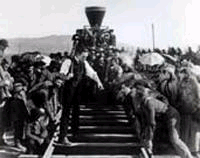 -
--
|
---- |
TWO EQUAL VERSIONS OF "THE IRON HORSE", DIRECTED BY JOHN FORD |
---- |
Starring:
|
George O'Brien |
David Brandon |
|
Madge Bellamy |
Miriam Marsh |
|
Judge Charles Edward Bull |
Abraham Lincoln |
|
William Walling |
Thomas Marsh |
|
Fred Kohler |
Deroux |
|
Cyril Chadwick |
Peter Jesson |
|
Gladys Hulette |
Ruby |
|
James Marcus |
Judge Haller |
|
Francis Powers |
Sergeant Slattery |
|
J.Farrell McDonald |
Corporal Casey |
|
James Welch |
Colonel "Buffalo Bill" Cody |
|
John Padjan |
Wild Bill Hickok |
|
Charles O'Malley |
Major North |
|
Charles Newton |
Collins P.Huntington |
|
Delbert Mann |
Charles Crocker |
|
Chief Big Tree |
Cheyenne chief |
|
Chief White Spear |
Sioux chief |
|
Edward Piel |
Old Chinaman |
|
James Gordon |
David Brandon, Sr. |
|
Winston Miller |
David, as child |
|
Peggy Cartwright |
Miriam, as child |
|
Thomas Durant |
Jack Ganzhorn |
|
Stanhope Wheatcroft |
John Hay |
|
Frances Teague |
Polka Dot |
|
Dan "Danny" Borzage |
-
|
---- |
First large success of John Ford, on the construction of transcontinental railway front line; the history is centralized on David Brandon that, while is looking for the assassin of its father, falls in love with an old flame of its adolescence (the father of the girl is itself one of the engineers of the railway enterprise) and he joins to the enterprise. Origin: USA 1924 As far as the silent period, Ford works with two camera operators four times. As far as the silent period, Ford makes to work George Schneiderman in While makes to work Burnett Guffey only in The Iron Horse Intertitles: Charles Darnton All the film appears as shoot with two cine-cameras placed side by side and the material realized with the right machine belongs to the RIGHT FILM, while the material realized with the machine of left belongs to the LEFT FILM. The cut of the negative would allow nearly a stereoscopic vision, because the cutting is identical, unless the length of every sequence differs little from the other and therefore the only thing of which it can be sure is the indications of cutting. In all the books consulted on John Ford does not appear minimal trace of these two equal versions and therefore it would be interesting to find declarations on this event. Of many films various versions exist according to destination markets, but never I had had news of two cuttings that exactly run parallels like a railroad (just like the primary subject of this film!). It is a fact that the material we can see belongs to same shoot and not to different camera take. |
---- |
 -
-
|
---- |
To distinguish the left version from that right is much easy one. Taking running time from the end of the opening titles: left - 5’17’’ Indian Chief in profile left - 15’ 30’’ Askew signature with motion picture camera to the left of Abraham Lincoln left - 78’ A dog lies down near a died Indian, that has the head on the left The lens focal lenght of the two cine cameras is identical, but that one of left has always a more narrow field, therefore it was a little more forward of that right. An hypothesis could be that the two cameramen had to be two buddies, but there is never a change of roles: to one it appealed to be on the left and to other to right, then everyone has collected its shooted and cut, while Ford wanted to see results, having a left film and one right, for some mysterious game of projection, comprised to be near rather than far away from the characters. For some strange reason the right version has some scene (at least two in the bar and one in exterior day to the train to 1h 25’) with a not fluid movement, like if a copy were with a shooted material more slowly, and therefore faster in projection, and it had been brought back to normal speed doubling the frames. It would be amusing to project two films on the same screen, inserting black detaches in order to bring back to par the cut of the two films. Maurizio Ferrari Go to ITALIAN VERSION |
---- |
♥
home ♥ mail ♥